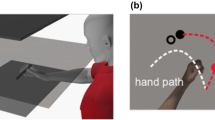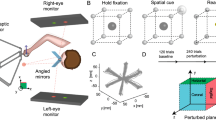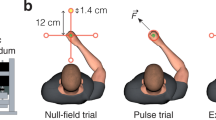Abstract.
In order to explore how subjects correct for errors in movement and adapt their motor programs, we studied rapid hand movements. Subjects grasped a grooved knob and made brisk turning movements to various targets, similar to tuning a radio dial. A motor attached to the knob shaft was configured to apply a destabilizing negative viscous perturbation. Following a period of practice with no perturbations, the negative viscosity was engaged, which caused a large change in overall kinematics: the peak velocity increased, the movement amplitude was too large, and discrete corrective submovements were generated to bring the pointer back onto the target. After about an hour and nearly 1000 trials, subjects learned to move accurately in the new dynamic environment, returning their overall kinematics near to previous levels. Measures of performance included the endpoint error of the primary movement (the initial movement segment), the frequency and amplitude of corrective submovements, task success rate, mean squared jerk, and deviation from a "normal" angular velocity temporal profile. Both the amplitude and frequency of corrective submovements decreased progressively during adaptation as the subjects made fewer target overshoot errors. These results are consistent with motor learning schemes in which adaptation of the motor controller is driven by an attempt to reduce the endpoint error of the primary movement. While there have been many theories regarding what is being optimized in motor control, in general, biologically plausible mechanisms for implementing these schemes have not been described. A biologically plausible optimization criterion is the minimization of the occurrence and amplitude of corrective submovements, since the latter have been proposed as realistic climbing fiber training signals for adaptive changes in the cerebellum. We postulate that the other criteria that have been proposed are instead secondary to an increased accuracy of the primary movement and a corresponding decrease in the occurrence and amplitude of corrective submovements.
Similar content being viewed by others
Author information
Authors and Affiliations
Additional information
Electronic Publication
Rights and permissions
About this article
Cite this article
Novak, .K., Miller, .L. & Houk, .J. Features of motor performance that drive adaptation in rapid hand movements. Exp Brain Res 148, 388–400 (2003). https://doi.org/10.1007/s00221-002-1288-1
Received:
Accepted:
Issue Date:
DOI: https://doi.org/10.1007/s00221-002-1288-1




